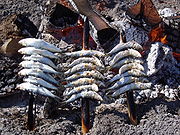
Sardine
About this schools Wikipedia selection
SOS Children produced this website for schools as well as this video website about Africa. SOS Children is the world's largest charity giving orphaned and abandoned children the chance of family life.

Sardines or pilchards are a group of several types of small oily fish related to herrings, family Clupeidae. Sardines were named after the island of Sardinia, where they were once in abundance.
The terms are not precise, and the usual meanings vary by region; for instance, to many people a "sardine" is a young European pilchard. A generalisation is that if the fish is under 4 inches long (10 cm) it is classed as a sardine, and if larger than 4 inches it is classed as a pilchard. The FAO/WHO Codex standard for canned sardines cites 21 species that may be classed as sardines; FishBase, a comprehensive database of information about fish, lists at least six species called just "pilchard," over a dozen called just "sardine," and many more with the two basic names qualified by various adjectives.
Canned "sardines" in supermarkets may actually be sprats (such as the "brisling sardine") or round herrings. The actual sizes of the fish canned varies by species. Good quality sardines should have the head and gills removed before packing. They may be also eviscerated before packing (typically the larger varieties), or not; if not eviscerated they should be free of undigested or partially digested food or feces (accomplished by holding the live fish in a tank for long enough that their digestive systems empty themselves). They may be packed in oil or some sort of sauce.
Classification
- Genus Dussumeria
- Rainbow sardine Dussumieria acuta
- Slender rainbow sardine Dussumieria elopsoides
- Genus Escualosa
- Slender white sardine Escualosa elongata
- White sardine Escualosa thoracata
- Genus Sardina
- European pilchard (true sardine) Sardina pilchardus
- Genus Sardinella
- Round sardinella (gilt sardine, Spanish sardine) Sardinella aurita
- Genus Sardinops
- South American pilchard (Pacific sardine, California sardine, Chilean sardine, South African sardine) Sardinops sagax (Jenyns, 1842)
Sardine in popular culture
Sardines are typically tightly packed in a small, flat can, the lid of which is scored for easy opening either with a pull tab, or a church key attached to the side of the can. Thus, it has the virtues of being an easily portable self-contained source of food, and often such things as sewing kits or survival kits are packed in a similar container . The close packing of sardines in the can has led to their being used metaphorically for any situation where people or objects are crowded together; for instance a bus or subway car.
Keralam
Sardines, locally called Maththi or Chala, is a favourite among Malayalees. However, the fish is typically used fresh and canned sardines are not popular. Fried sardines are a sought after delicacy, particularly in the Malabar area. In the districts of North Malabar the fish is also used in curries. Chala is cheaper in Keralam (compared to larger fish like the Seer or Pomfret) making it a common man's delicacy.
United Kingdom (Cornwall)
Pilchard fishing and processing was a thriving industry in Cornwall from around 1750 to around 1880, after which it went into an almost terminal decline. However, as of 2007, stocks are improving (q.v. River Cottage: Gone Fishing 22/11/08).
The industry has featured in numerous works of art, particularly by Stanhope Forbes and other Newlyn School artists.
A traditional Cornish pilchard dish is stargazy pie or starry gazy pie.
Spain (Canary Islands)
In the Timanfaya Volcanic National Park on Lanzarote, a popular tourist menu is to eat sardines, freshly caught that morning, grilled over the heat from a volcanic vent.
Portugal
Sardines play an important role in Portuguese culture. Having been a people who depended heavily on the sea for food and commerce, the Portuguese have a predilection for fish in their popular festivities. The most important is Saint Anthony's day, 13th June, when the biggest popular festival takes place in Lisbon, taking the people to the streets where grilled sardines are the snack of choice. Almost every place in Portugal, from Figueira da Foz to Portalegre, or from Póvoa de Varzim to Olhão has the summertime popular tradition of eating grilled sardines (sardinhas assadas).
Croatia
Fishing for sardela or sardina (Sardina pilchardus) on the Croatian Adriatic coasts of Dalmatia and Istria is an ongoing activity tracing its roots back thousands of years. The region was part of the Roman Empire, then largely a Venetian dominion, and has always been sustained through fishing mainly sardines. All along the coast there are many towns that promote the age-old practice of fishing by latin-sail type boats for tourism and on festival occasions. Today this tradition is also continued by many producers.
Healthy Food
Sardines are also healthy and considered a "brain food." These fish are rich in omega 3 fatty acids, which can help maintain a healthy heart. Recent studies suggest that omega 3 fatty acids slow the progression of mild to moderate Alzheimer's disease. These fatty acids can also help control blood sugar level. Not only are sardines packed with omega 3 fatty acids but they are also a good source of vitamin D, calcium and B12. .



